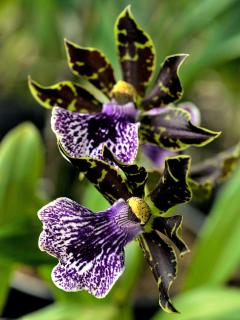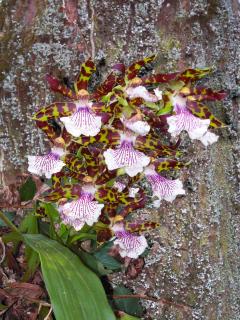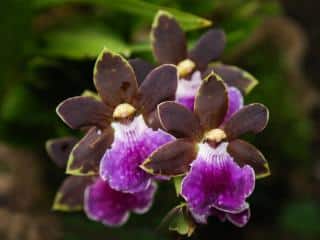

Zygopetalum is a family of orchids native to Brazil and Columbia.
Key Zygopetalum facts
Botanical name: Zygopetalum
Family: Orchidaceae
Type: epiphyte, sometimes ground
Origin: Brazil and Columbia
Height: 16 in to 3 feet (40 cm to 1 m)
Flowering: winter
Flower color: white, tan, pink, purple… all together
Diseases and pests: scale, mites, rot
Exposure: lots of light – Hardiness: not hardy – Soil: well-draining, for orchids
Here are all our tips to care for Zygopetalum orchids and benefit from their incredible, colorful blooms.
Varieties found in garden stores are quite easy to care for. The surprising blooms of Zygopetalum are covered with spots or stripes. They appear in winter and release a pleasant scent throughout the house.

From the buds, long narrow leaves appear. These are lance-shaped and a shiny bright green color.
The floral scape reaches anywhere from 1 to 3 feet tall (25 to 90 cm), and it emerges from between the pseudobulb and the lowest leaves. From 2 to 15 wax-like flowers find their place on each stem.
They’re often very fragrant. Spicy and floral is sometimes used to describe this heady, sharp scent. Petals and sepals are usually green and brown, whereas the impressive large labellum is white with streaks of blue, violet and purple.

As a temperate climate orchid, Zygopetalum must grow in a place with no heating. Temperatures must hover around:
During summer, Zygopetalum loves it when temperatures swing strongly between night and day: this triggers blooming.
Zygopetalum needs a pot with special orchid mix that contains bark, 20% peat, and a little perlite.
A fast grower, hybrid Zygopetalum tend to quickly extend out of its pot. It doesn’t like feeling cramped, so the way forward is to repot your orchid every year in spring, as soon as the blooming has died off. Note that wild species don’t need such frequent repotting, usually every 2 to 3 years is enough.
Zygopetalum needs relatively moist substrate at all times, though never to the point that it gets all soggy. From spring to summer, use soft water as soon as the surface of the pot starts drying out (once a week on average). In winter, you won’t need to water as often: once every 3 weeks is enough.
No need to mist this orchid in winter. However, in summer, you can set the pot on a bed of clay pebbles in a saucer filled with water: this increases air moisture around the plant.

Use a diluted fertilizer made specifically for orchids, and give it together with your watering every fortnight. Idealy, you’d give this fertilizer by soaking the entire root section for an hour. After that, lift it out of the water/fertilizer mix, and let excess water drip away. When it stops dripping, you can settle it back in its pot.
Note: water at least once abundantly without fertilizer before applying fertilizer again. Washing out unused fertilizer is important to avoid buildup of minerals around the Zygopetalum’s roots.